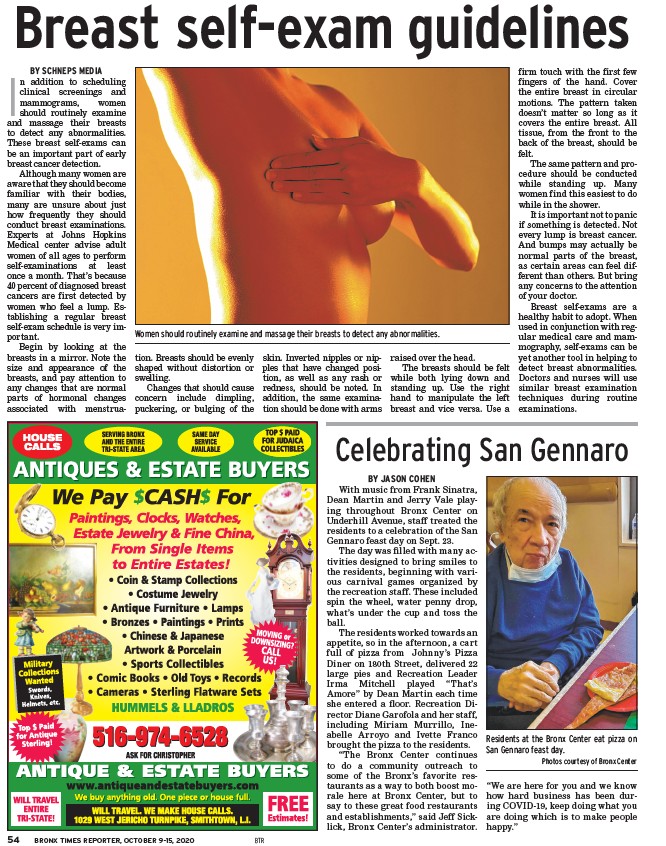
Breast self-exam guidelines
BRONX TIMES REPORTER,54 OCTOBER 9-15, 2020 BTR
BY JASON COHEN
With music from Frank Sinatra,
Dean Martin and Jerry Vale playing
throughout Bronx Center on
Underhill Avenue, staff treated the
residents to a celebration of the San
Gennaro feast day on Sept. 23.
The day was fi lled with many activities
designed to bring smiles to
the residents, beginning with various
carnival games organized by
the recreation staff. These included
spin the wheel, water penny drop,
what’s under the cup and toss the
ball.
The residents worked towards an
appetite, so in the afternoon, a cart
full of pizza from Johnny’s Pizza
Diner on 180th Street, delivered 22
large pies and Recreation Leader
Irma Mitchell played “That’s
Amore” by Dean Martin each time
she entered a fl oor. Recreation Director
Diane Garofola and her staff,
including Miriam Murrillo, Ineabelle
Arroyo and Ivette Franco
brought the pizza to the residents.
“The Bronx Center continues
to do a community outreach to
some of the Bronx’s favorite restaurants
as a way to both boost morale
here at Bronx Center, but to
say to these great food restaurants
and establishments,” said Jeff Sicklick,
Bronx Center’s administrator.
Residents at the Bronx Center eat pizza on
San Gennaro feast day.
Photos courtesy of Bronx Center
“We are here for you and we know
how hard business has been during
COVID-19, keep doing what you
are doing which is to make people
happy.”
IBY SCHNEPS MEDIA n addition to scheduling
clinical screenings and
mammograms, women
should routinely examine
and massage their breasts
to detect any abnormalities.
These breast self-exams can
be an important part of early
breast cancer detection.
Although many women are
aware that they should become
familiar with their bodies,
many are unsure about just
how frequently they should
conduct breast examinations.
Experts at Johns Hopkins
Medical center advise adult
women of all ages to perform
self-examinations at least
once a month. That’s because
40 percent of diagnosed breast
cancers are first detected by
women who feel a lump. Establishing
a regular breast
self-exam schedule is very important.
Begin by looking at the
breasts in a mirror. Note the
size and appearance of the
breasts, and pay attention to
any changes that are normal
parts of hormonal changes
associated with menstruation.
Breasts should be evenly
shaped without distortion or
swelling.
Changes that should cause
concern include dimpling,
puckering, or bulging of the
skin. Inverted nipples or nipples
that have changed position,
as well as any rash or
redness, should be noted. In
addition, the same examination
should be done with arms
raised over the head.
The breasts should be felt
while both lying down and
standing up. Use the right
hand to manipulate the left
breast and vice versa. Use a
firm touch with the first few
fingers of the hand. Cover
the entire breast in circular
motions. The pattern taken
doesn’t matter so long as it
covers the entire breast. All
tissue, from the front to the
back of the breast, should be
felt.T
he same pattern and procedure
should be conducted
while standing up. Many
women find this easiest to do
while in the shower.
It is important not to panic
if something is detected. Not
every lump is breast cancer.
And bumps may actually be
normal parts of the breast,
as certain areas can feel different
than others. But bring
any concerns to the attention
of your doctor.
Breast self-exams are a
healthy habit to adopt. When
used in conjunction with regular
medical care and mammography,
self-exams can be
yet another tool in helping to
detect breast abnormalities.
Doctors and nurses will use
similar breast examination
techniques during routine
examinations.
Women should routinely examine and massage their breasts to detect any abnormalities.
Celebrating San Gennaro